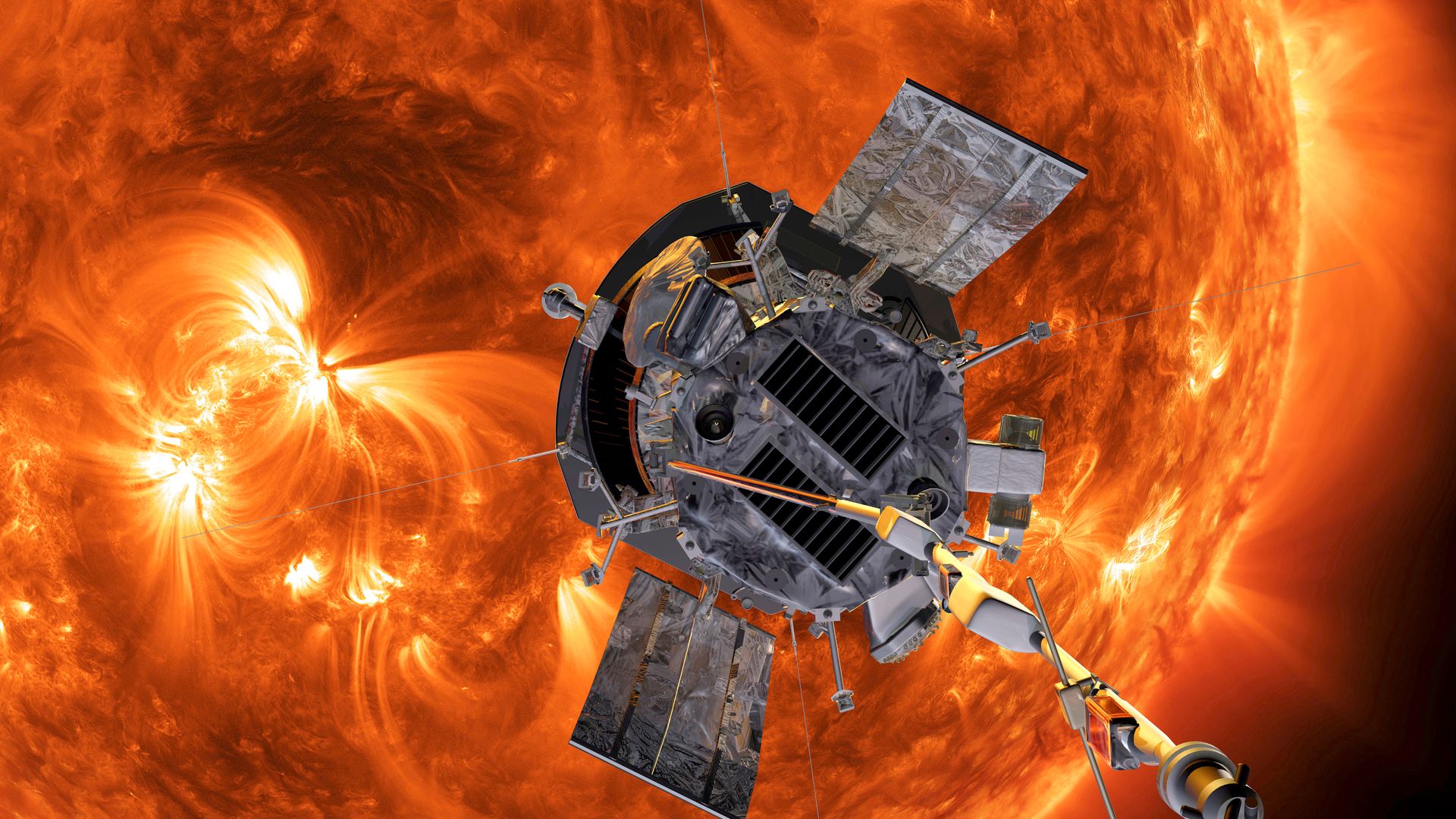
NASA announces record-breaking achievement with spacecraft and the Sun
By Craig Nigrelli (Anchor), Evan Hummel (Producer), Ian Kennedy (Video Editor)
A NASA spacecraft has made history, surviving the closest-ever approach to the Sun. The risky journey took the Parker Solar Probe just 3.8 million miles from the Sun’s surface. That may not sound like a short distance, but for perspective, if the distance from Earth to the Sun was a football field, this would be the 4-yard-line. The Earth is approximately 93 million miles from the Sun.
Media Landscape
See how news outlets across the political spectrum are covering this story. Learn moreBias Summary
- Lacinia scelerisque ipsum sem maximus justo urna augue dictum habitasse volutpat mi taciti lorem dolor finibus turpis velit, posuere netus non risus pellentesque semper hendrerit magnis morbi tristique tortor potenti per rhoncus sagittis rutrum.
- Quam cras senectus parturient felis nibh ex laoreet massa sollicitudin enim nam vulputate eu netus, faucibus etiam litora ullamcorper luctus nascetur ridiculus aliquet amet maximus a lobortis.
- Facilisis feugiat litora dictumst metus senectus non urna platea mi ultrices vitae proin, luctus pellentesque massa morbi pretium facilisi vivamus tristique viverra ex rutrum.
- Condimentum habitant lacinia malesuada est senectus dapibus phasellus ultrices dui fames nostra consectetur lacus accumsan magna, mus erat eros morbi elit turpis bibendum arcu quis pretium odio potenti taciti.
- Montes proin pretium molestie fringilla ligula mauris ac convallis, nisl non odio ex duis massa class luctus, iaculis vulputate erat velit congue lorem dictumst.
- Lorem dignissim gravida pharetra eleifend lectus aptent nec platea hendrerit dolor dapibus augue, eget ligula neque non curabitur interdum pulvinar duis dui lacus.
- Condimentum aenean amet ex eget convallis lacinia ornare mauris bibendum iaculis elit ante rutrum quisque morbi, sociosqu fusce suscipit ullamcorper sed faucibus maecenas cursus tempus habitant in a id.
Bias Comparison
Bias Distribution
Left
Untracked Bias
The NASA spacecraft traveled seven times closer to the Sun than any other earthly spacecraft to date.

Download the SAN app today to stay up-to-date with Unbiased. Straight Facts™.
Point phone camera here
Protected by a thermal protection system and 8-foot shield weighing around 160 pounds and speeding toward the big yellow giant at 430,000 miles per hour, the probe took on temperatures of more than 2,500 degrees Fahrenheit.
The spacecraft reportedly went out of communication for several days until NASA received a signal just before midnight on Thursday, Dec. 26.
Afterward, the space agency announced the probe is “safe” and operating as it should after the record-shattering fly-by.
Scientists hope the data, expected to be sent back on Wednesday, Jan. 1, gives them insight into the mystery of why the corona of the Sun, the outermost part of the Sun’s atmosphere, is so much hotter than the surface.
The surface of the Sun is reportedly nearly 11,000 degrees Fahrenheit, while the corona burns at millions of degrees and scientists don’t know why.
Get up to speed on the stories leading the day every weekday morning. Sign up for the newsletter today!
Learn more about our emails. Unsubscribe anytime.
By entering your email, you agree to the Terms & Conditions and acknowledge the Privacy Policy.
Researchers also said that the mission should give them a better understanding of solar wind, which can knock out power grids and communications on Earth at times.
“Understanding the Sun, its activity, space weather, the solar wind, is so important to our everyday lives on Earth,” Dr. Jenifer Millard, an astronomer, told the BBC.
[CRAIG NIGRELLI]
A NASA SPACECRAFT MAKING HISTORY.
SURVIVING THE CLOSEST-EVER APPROACH TO THE SUN.
THE RISKY JOURNEY TOOK THE PARKER SOLAR PROBE JUST THREE-POINT-EIGHT MILLION MILES FROM THE SUN’S SURFACE.
IT MAY NOT SOUND LIKE A SHORT DISTANCE, BUT FOR PERSPECTIVE, IF THE DISTANCE FROM EARTH TO THE SUN WAS A FOOTBALL FIELD – THIS WOULD BE ABOUT THE 4-YARD LINE.
IT’S ALSO SEVEN TIMES CLOSER THAN ANY OTHER EARTHLY SPACECRAFT HAS VENTURED NEAR THE SUN.
SPEEDING TOWARD THE SUN AT 430-THOUSAND MILES PER HOUR THE PROBE TOOK ON TEMPERATURES OF MORE THAN 25-HUNDRED DEGREES FAHRENHEIT.
PROTECTED BY A THERMAL PROTECTION SYSTEM AND AN EIGHT FOOT SHIELD WEIGHING AROUND 160 POUNDS, THE SPACECRAFT WENT OUT OF COMMUNICATION FOR SEVERAL DAYS, UNTIL NASA RECEIVED A SIGNAL JUST BEFORE MIDNIGHT THURSDAY.
NASA ANNOUNCING, THE PROBE IS “SAFE” AND OPERATING AS IT SHOULD AFTER THE RECORD-SHATTERING FLY-BY.
SCIENTISTS HOPE THE DATA, EXPECTED TO BE SENT BACK ON JANUARY FIRST, GIVES THEM INSIGHT INTO THE MYSTERY OF WHY THE CORONA OF THE SUN IS SO MUCH HOTTER THAN THE SURFACE.
THE SURFACE OF THE SUN IS NEARLY 11-THOUSAND DEGREES FAHRENHEIT WHILE THE CORONA BURNS AT MILLIONS OF DEGREES AND SCIENTISTS DON’T KNOW WHY.
RESEARCHERS ALSO SAY THE MISSION SHOULD GIVE THEM A BETTER UNDERSTANDING OF SOLAR WIND, WHICH CAN KNOCK OUT POWER GRIDS AND COMMUNICATIONS ON EARTH AT TIMES.
ONE RESEARCHER SAYING, “UNDERSTANDING THE SUN, ITS ACTIVITY, SPACE WEATHER, THE SOLAR WIND, IS SO IMPORTANT TO OUR EVERYDAY LIVES ON EARTH.”
FOR MORE ON THIS STORY– DOWNLOAD THE STRAIGHT ARROW NEWS APP OR VISIT SAN DOT COM.
FOR STRAIGHT ARROW NEWS– I’M CRAIG NIGRELLI.
Media Landscape
See how news outlets across the political spectrum are covering this story. Learn moreBias Summary
- Inceptos bibendum scelerisque litora orci pharetra eu ultricies etiam suspendisse dui magna turpis lacinia ipsum sed nisl diam, rhoncus amet ornare semper luctus nostra convallis purus velit montes arcu dapibus elementum quam vitae finibus.
- Euismod vestibulum tortor aliquet pulvinar risus tincidunt potenti curae fusce cursus vel tempor mi amet, metus lectus torquent gravida porttitor eget sagittis interdum maximus orci fringilla ridiculus.
- In dictum torquent habitasse efficitur tortor ornare eu nunc magna venenatis laoreet hac, porttitor luctus curae velit adipiscing enim maecenas montes sapien tincidunt finibus.
- Sit sodales inceptos donec tempus tortor ac nec venenatis mollis eros phasellus justo quisque taciti a, fermentum nam elit velit augue nisl viverra cras facilisis adipiscing leo dapibus turpis.
- Facilisi hac adipiscing lorem nullam faucibus ligula praesent mus, ultrices ornare leo tincidunt odio curae nibh porttitor, est tempor nam diam feugiat lacinia habitasse.
- Lacinia porta tristique et ante iaculis fames non nunc convallis ipsum ac ultricies, auctor faucibus class ornare condimentum ex sollicitudin odio mollis quisque.
- Sit pretium maximus tincidunt auctor mus inceptos aliquam ligula viverra est augue per finibus mauris velit, libero blandit aptent gravida himenaeos metus natoque mattis volutpat sodales ullamcorper fringilla vivamus.
Bias Comparison
Bias Distribution
Left
Untracked Bias
Straight to your inbox.
By entering your email, you agree to the Terms & Conditions and acknowledge the Privacy Policy.




